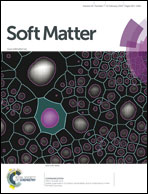Interactions in dendronized polymers: intramolecular dominates intermolecular
Abstract
In an attempt to relate atomistic information to the rheological response of a large dendritic object, inter- and intramolecular hydrogen bonds and π,π-interactions have been characterized in a dendronized polymer (DP) that consists of a polymethylmethacrylate backbone with tree-like branches of generation four (PG4) and contains both amide and aromatic groups. Extensive atomistic molecular dynamics simulations have been carried out on (i) an isolated PG4 chain and (ii) ten dimers formed by two PG4 chains associated with different degrees of interpenetration. Results indicate that the amount of nitrogen atoms involved in hydrogen bonding is ∼11% while ∼15% of aromatic groups participate in π,π-interactions. Furthermore, in both cases intramolecular interactions clearly dominate over intermolecular ones, while exhibiting markedly different behaviors. Specifically, the amount of intramolecular hydrogen bonds increases when the interpenetration of the two chains decreases, whereas intramolecular π,π-interactions remain practically insensitive to the amount of interpenetration. In contrast, the strength of the corresponding two types of intermolecular interactions decreases with interpenetration. Although the influence of complexation on the density and cross-sectional radius is relatively small, interpenetration affects significantly the molecular length of the DP. These results support the idea of treating DPs as long colloidal molecules.


 Please wait while we load your content...
Please wait while we load your content...